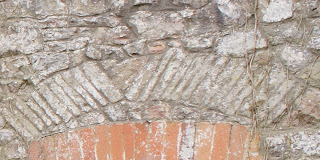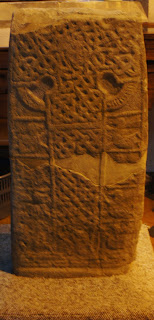 The Book of Llandâf mentions (31,43 and 90pp) ‘villam Sancti Nuvien cum ecclesia’ Later Ecclesia Marmouric id est Lann Uvien (p206'Marmouric' means 'Meurig's place . At the east end of the window there are two square windows with a good rose window in between. At one time it was attached to Caerwent, for in an inspection of 1336 recording of theadvowson of Caerwent we read
The Book of Llandâf mentions (31,43 and 90pp) ‘villam Sancti Nuvien cum ecclesia’ Later Ecclesia Marmouric id est Lann Uvien (p206'Marmouric' means 'Meurig's place . At the east end of the window there are two square windows with a good rose window in between. At one time it was attached to Caerwent, for in an inspection of 1336 recording of theadvowson of Caerwent we read'cum capellis de Llannayre Dynan et Sancti Nyveyn (al niveyn) eidem Ecclesiae annexis'.(arch cam 1909 pp 113-4)
 There are other instances of the disappearance of the initial ‘n’ due to ‘Lann’ coming before its name.There is also the reference in the book of Llandaff, to Bishop urban, trying to boost the claim to Llandaff as a diocese, and possible archbishop, of all the small Welsh chapels being rededicated to long forgotten saints after their brief use by Saxon priests.It is possible at this time that there was confusion over St Nwyfan (a North Wales saint) and St Nefyn (granddaughter of Brychan, whom I believe is much more likely in the South Wales location). However Baring Gould and Fisher suggest that Nuvern was a male saint.
There are other instances of the disappearance of the initial ‘n’ due to ‘Lann’ coming before its name.There is also the reference in the book of Llandaff, to Bishop urban, trying to boost the claim to Llandaff as a diocese, and possible archbishop, of all the small Welsh chapels being rededicated to long forgotten saints after their brief use by Saxon priests.It is possible at this time that there was confusion over St Nwyfan (a North Wales saint) and St Nefyn (granddaughter of Brychan, whom I believe is much more likely in the South Wales location). However Baring Gould and Fisher suggest that Nuvern was a male saint.There is no reference to it being a llan in the Book of Llandaff, however it is possible, since Nefyn being a King's granddaughter is unlikely to have been left as a hermit.
King Meurig and his father, the Martyr TewdrigMamouric mean’s ‘Meurig’s place’ and this location probably fits the son of King Tewdrig (tomb in Caerwent Church). Meurig is the Welsh version of ‘Maurice’ As a soldier he was named after this saint, St Maurice (Moritz) being a popular martyr all over Europe.Meurig and Tewdrig were Kings of Morgannwg. St Tewdrig had
secured his martyrdom fighting alongside Meurig against the pagan Saxons at Brockweir and brought his dying father to Mathern.
Among the places mentioned in the area are ‘Aper Pull Muric’ (anglicised to Pwllmerrick) and ‘Aper pull Neuynn’(Liber L p142-3)369 not necessarily named the ‘Mouth of the Hunger Pill ‘ as it has been-but perhaps the pool of Nyfern.
Archeologica Cambrensis mentions the mansion as being almost in its original state. The remains of the chapel of Nefyn or of Nyfain are still to be seen, converted into a barn in the yard of the old Manor House of Crick, an old house which is today almost in its original state.
At the east end of the chapel are two square windows with a good rose window in between. It appears to have been attached to Caerwent at one time, for an inspeximus of 1336 recording the grant of the advowson (administration)of Caerwent, we read
‘cum capella de Llanyre Dynan, et Sancti Nyveyn (al Niveyn)eidem Ecclesiae annexia(Willis :Llandaff 1719)
In Henry VIII valor of 1535, however,the church of Mathern is described as ‘The Parish Church of Matherne, Trikke and Rulston (Runston) Trikke is a misspelling of Crick, situated just within the border of the old parish of Runston.
The setting of St Nyvern chapel and Crick Manor and their open relationship with the valley to the north east are beautiful and maintained and the impacts of the nearby commercial use have been mitigated. It has a positive link to Bradbury;s farm and so there is a rural feel to the chapel cottage (sometime called 'Brook Cottage')
Sir Joseph Bradney in ‘A History of Monmouth’ writes the following.
In the ‘Manor of (p140) the ancient mansion stands on the north side of the road. The windows with stone mullions, appear to be of early Tudor period. The hall is raised five feet off the ground, the kitchens being of a lower level.
Crick,’ he writes
>If you look carefully, you can see the rose window traced in the wall.
Bradney writes: 'Within a few yards is the chapel, dedicated to St Nefyn, granddaughter of Brychan and wife of Cynfarch Oer. Their son was Urien Rheged'. At the east end of the chapel, which is now used as a barn, are two lancet windows. The Chapel was used as late as 1616 when on 13th January Nicholas More married Cecilia More in Cricke Chapell. In the orchard next to the fold yard is a square plot of ground, surrounded by a shallow moat. This, doubtless is the site of the original castle or small fortress erected by William Denford, which in the fifteenth or early part of the 16th century was deserted and the present house was built out of the materials.by William Denford, which in the fifteenth of early part of the 16th century was deserted and the presnt house built out of the materials.
St Nuvern's Chapel is now a private cottage.
St Nuvern's Chapel is now a private cottage.





































